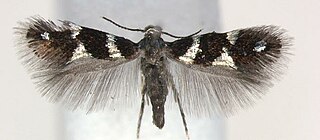External links
| | This article on a moth of the family Nepticulidae is a stub. You can help Wikipedia by expanding it. |
| Parafomoria | |
|---|---|
| Scientific classification | |
| Kingdom: | |
| Phylum: | |
| Class: | |
| Order: | |
| Family: | |
| Genus: | Parafomoria Borkowski, 1975 |
Parafomoria is a genus of moths of the family Nepticulidae.

Ypsolophidae is a family of moths with some 160 species. They are included in the Plutellidae by many authors.

The Drepanidae are a family of moths with about 660 species described worldwide. They are generally divided in three subfamilies, which share the same type of hearing organ. Thyatirinae, previously often placed in their own family, bear a superficial resemblance to Noctuidae. Many species in the drepanid family have a distinctively hook-shaped apex to the fore wing, leading to their common name of hook-tips.

Adeloidea is a superfamily of primitive monotrysian moths in the order Lepidoptera which consists of leafcutters, yucca moths and relatives. This superfamily is characterised by a piercing, extensible ovipositor used for laying eggs in plants. Many species are day-flying with metallic patterns.

The Wereldmuseum Amsterdam is an ethnographic museum located in Amsterdam, Netherlands, founded in 1864.

The Glyphipterigidae are a family of small moths commonly known as sedge moths, as the larvae of many species feed on sedges and rushes. More than 500 species have been described in the family.

Lyonetiidae is a family of moths with some 200 described species. These are small, slender moths, the wingspan rarely exceeding 1 cm. The very narrow forewings, held folded backwards covering the hindwings and abdomen, often have pointed apices noticeably up- or down-turned. The larvae are leaf miners.

The Heliozelidae, commonly known as shield-bearer moths, are a family of small, day flying monotrysian moths distributed worldwide. The larvae of most heliozelid species are leaf miners who cut distinctive shield-shaped cases from the surface of the host leaf, hence the common name. Some species are considered pests of commercial crops such as grapevines, cranberries, and walnuts. The taxonomy of this family is poorly understood.
Ectoedemia is a genus of moths in the family Nepticulidae. It consists of the subgenera Ectoedemia, Etainia, Fomoria and Zimmermannia. This genus was established by August Busck in 1907.
Stigmella is a genus of moths of the family Nepticulidae. The genus was erected by Franz von Paula Schrank in 1802.
Stigmella rolandi is a moth of the family Nepticulidae. It is found from Germany to the Iberian Peninsula, Sardinia, Italy and Greece, and from France to central en southern Russia. It is also present in the Near East.
Acalyptris is a genus of moths of the family Nepticulidae.

Pectinivalva is a genus of moths of the family Nepticulidae.
Trifurcula is a genus of moths of the family Nepticulidae. For the Triassic aged ray-fin "Glaucolepis" Stensiö, 1921 see Pteronisculus.

Parafomoria pseudocistivora is a moth of the family Nepticulidae. It is probably found in the whole Mediterranean region.
Parafomoria helianthemella is a moth of the family Nepticulidae. It is found in central and southern Europe, including Germany, south-eastern Poland, the Czech Republic, Slovakia, Hungary, Austria, Switzerland, northern Italy, France and Bulgaria.
Parafomoria ladaniphila is a moth of the family Nepticulidae. It is found in Morocco and Portugal.
Parafomoria halimivora is a moth of the family Nepticulidae. It is found in the Iberian Peninsula.

Eulepidoptera is a division of lepidopterans in the infraorder Heteroneura.